
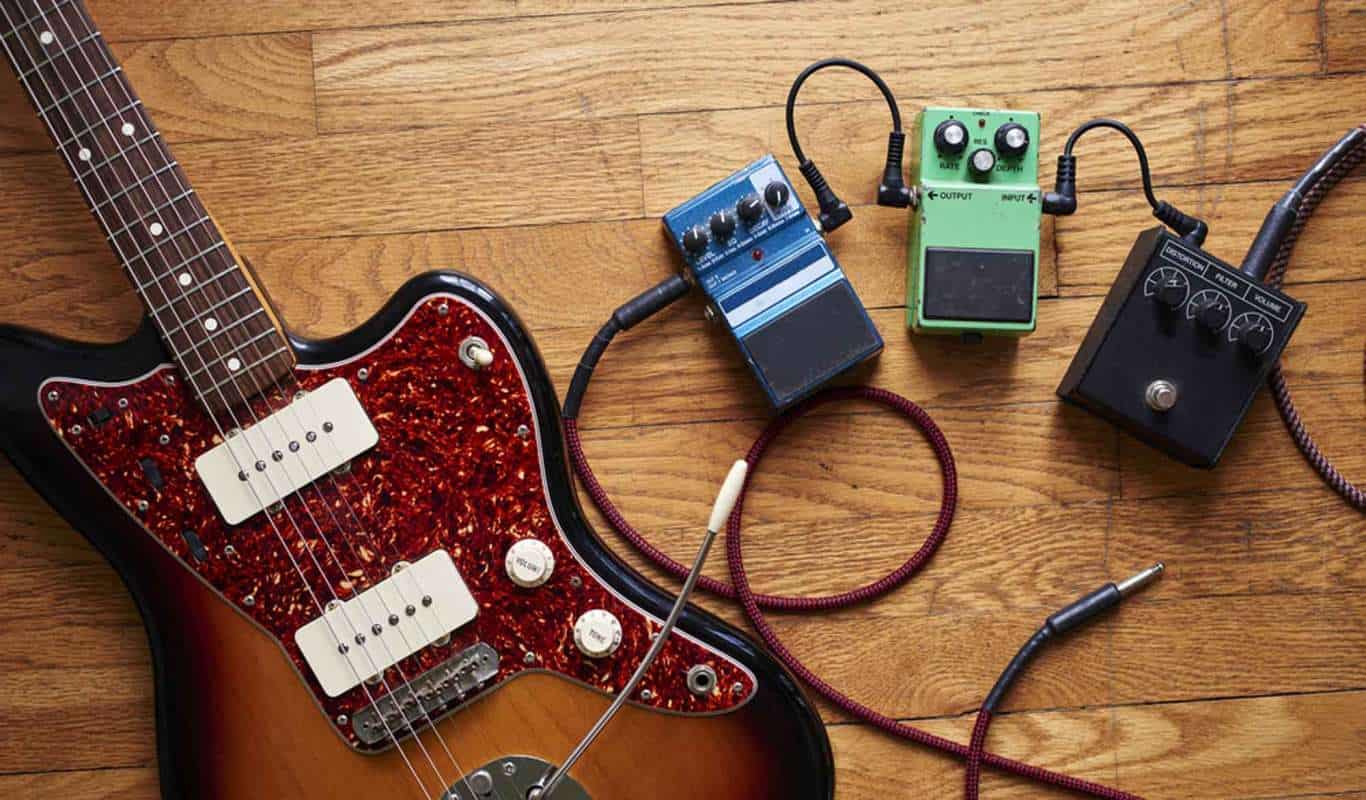
Don’t want to sacrifice sound or spend a lot of cash? Find the perfect balance with the best delay pedal reviews.
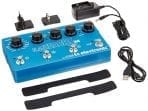 TC Electronic Flashback X4 Delay E ffects Pedal
TC Electronic Flashback X4 Delay E ffects Pedal
Compatible with MIDI tempo syncing and external expression pedals
40-second loop with undo and independent engine
True bypass and analog dry through maintain signal integrity
On the pricier side
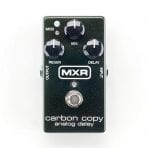 MXR M169 Carbon Copy Analog Delay
MXR M169 Carbon Copy Analog Delay
Relatively small footprint
Very versatile pedal, capable of a wide range of effect styles
Consistent and reliable performance
Not as durable long-term as other options
 JOYO D-SEED Dual Channel Effect Pedal with Four Modes
JOYO D-SEED Dual Channel Effect Pedal with Four Modes
Excellent value
Wide range of delay time options
Automatically saves your settings
Input for external trigger lets you use a footswich to switch channels
Large footprint
Settings can be difficult to dial in
Eventide TimeFactor Twin Delay Pedal
An excellent pedal for both delay and loop effects, although it’s priced a bit out of many people’s budget.
Very durable cast metal casing
Extensive controls allow you to produce any style of delay or loop effect
Inputs and outputs for both guitar and line level
Studio-ready sound with a true analog signal bypass
Large footprint
Most expensive pedal on the list
DELAY LAY LAY Delay Effect Pedal by Deadbeat Sound
An affordable analog delay pedal with self-oscillating capabilities.
Warm analog delay sound
Smooth knobs let you really dial in on your tone
Especially affordable for an analog delay pedal
Casing doesn’t feel quite as sturdy as some of the others on the list
Only offers one effect
TC Electronic Nova Delay Effects Pedal
A versatile pedal with programmable presets, making it quick and easy to dial in.
True stereo inputs give more depth to your tone
Dedicated footswitch for activating tap tempo mode
Studio-quality sound ranging from vintage to modern
Large, easy-to-read LCD display can be set to display MS or BPM
Presets may restore to defaults if pedal is out of use for long periods
Can generate some signal noise
Donner Multi Digital Echo Square Pedal 7 Modes
An impressively compact delay pedal, with a lot more features than you might expect from the size.
Very affordable
One of the most compact pedals on the list
Unique, full sound on all the modes
Control knobs don’t click into place
No option for battery power
Zoom ZMS70CDR MS-70CR Pedal
A compact multi-effects pedal with 26 delay styles that’s a good choice if you need a delay pedal and then some.
Can use up to 6 effects at once
Delays fade naturally thanks to the Tail function
Also includes common effects like reverb, tremolo, and pitch shifting
Doesn’t offer as much customization for each effect
Doesn’t run especially well on battery power (better to use an adapter)
Boss RC-1 Loop Station
While its features are aimed more at loop than delay effects, it’s an option if you want a longer delay than other pedals can give you.
Retains recorded material in memory even when powered off
Stereo ins and outs
Easy to use and read
Designed more for looping than delay
10 Killer Delay Pedals to Add Depth to Your Tone in 2025

He works as a DJ at night. The main work on a music label. He plays the guitar and a real music lover.
Cecil P. Lindenberg A delay pedal is a necessary piece of gear for many guitarists. The main reason for their popularity is they can do so many different things for your sound. The best delay pedal can be used not only as an effect to add more texture to your tone, it can also add a more subtle depth and shimmer that make you sound like a polished professional.
A delay pedal is a necessary piece of gear for many guitarists. The main reason for their popularity is they can do so many different things for your sound. The best delay pedal can be used not only as an effect to add more texture to your tone, it can also add a more subtle depth and shimmer that make you sound like a polished professional.
Because it’s such a versatile effect, there are many different options out there when it comes to delay pedals. Whether a pedal is analog or digital, how many delay modes it offers, and what kinds of tone-shaping controls are available will all impact the overall sound of the effect. We’ve rounded up ten of our favorite delay pedals below to help you get started on your search.
When you’re buying an effects pedal, you’re mostly shopping with your ears.
But if you think that’s all there is to it, think again!.
The truth is, there are factors to consider even beyond finding your perfect sound. In fact, when were testing these pedals out, we considered a variety of factors, including reliability, ease of use, value…
And, yes, sound, too!
We also gathered feedback from players who actually own and use the pedals to get a sense of how they do long-term in the real world. On top of that, we found out which pedals the pros use and recommend.
The culmination of that research is in the list below.
TC Electronic makes a wide variety of different effects pedals. You can pretty much find something in their catalog for every effect and any style of player (you’ll see their name again before this list is finished).
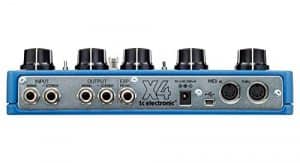 The Flashback is a stompbox specifically designed for professional guitarists to use on-stage. With included loop effects as well as 16 modes of delay, it’s maybe the ideal blend of comprehensive effects with easy usability.
The Flashback is a stompbox specifically designed for professional guitarists to use on-stage. With included loop effects as well as 16 modes of delay, it’s maybe the ideal blend of comprehensive effects with easy usability.
The X4 in this pedals name refers to the fact that this is basically four pedals in one. It also has four foot switches, four control knobs, and four slots for TonePrint presets, which you can send to the pedal from any laptop or smartphone.
Basically you can think of this as four times the pedal, and the loop function isn’t a throwaway, either. You’ll get up to 40 seconds of loop, on an engine that’s completely independent of the delay effect.
It’s true—this is a lot of pedal.
Its versatility makes it well worth it, though, and despite all the different options it offers it’s easy to dial in the perfect sound every time.
Features:
Compatible with MIDI tempo syncing and external expression pedals
40-second loop with undo and independent engine
True bypass and analog dry through maintain signal integrity
On the pricier side
A lot of digital delay pedals sound fantastic, but they can’t quite emulate the sound of an analog effect. If you want this old-school sound from a modern pedal, you have to check out the Carbon Copy from MXR.
The sound that comes out of it is as rich as what you’ll get from a vintage pedal, and its modern circuitry makes it both more reliable and more versatile.
 The Carbon Copy uses a clean, classic three-knob stompbox design. There are two trim pots inside the pedal for tweaking the rate and width of the effect, giving you more ways to customize the sound without cluttering the interface.
The Carbon Copy uses a clean, classic three-knob stompbox design. There are two trim pots inside the pedal for tweaking the rate and width of the effect, giving you more ways to customize the sound without cluttering the interface.
The only disadvantage of this approach is that it’s harder to make on the fly adjustments, but if you typically take a more “set it and forget it” approach to your effects it’s an excellent compromise.
Generally speaking, though, it’s easy to use this pedal.
And to make it do what you want.
The knobs are smooth-turning and give you a nice even, gradual change, making it easy to hone in on your ideal sound. And it’s that sound that really caught our attention with the MXR M169. It has a fat saturation and quick distortion that in many ways make it the ideal analog effects pedal (especially in its price point).
Features:
Relatively small footprint
Very versatile pedal, capable of a wide range of effect styles
Consistent and reliable performance
Not as durable long-term as other options
Joyo has made their name as a company by putting out affordable clones of classic and popular effects. This dual-channel delay pedal isn’t the cheapest option on the list, but it’s definitely on the cheaper end of the spectrum.
Considering the features and functions that come included, it’s definitely in keeping with Joyo’s reputation for value.
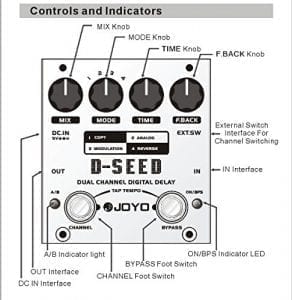 The two-channel design of this pedal is definitely the feature that makes it stand out the most. It’s especially helpful that each of the channels has its own independent settings options, letting you fine-tune your sound to a greater degree than most effect pedals allow.
The two-channel design of this pedal is definitely the feature that makes it stand out the most. It’s especially helpful that each of the channels has its own independent settings options, letting you fine-tune your sound to a greater degree than most effect pedals allow.
There are also overall controls for changing the mode, as well as the standard options for adjusting the mix and feedback.
While there’s a lot to love about the Joyo D-SEED, our favorite feature is the tap tempo mode.
This lets you choose the amount of delay and extends the potential delay time to 6,000ms, a degree of control that many delay pedals don’t give you.
The only complaint we have about this pedal is that it’s not the easiest to use.
The settings can be tricky to dial in, especially when you’re first learning how to use it. Setting the tap tempo mode also isn’t especially intuitive, and it’s not the best option if you want to change your settings quickly.
Nevertheless...
It’s the most comprehensive delay pedal you’ll find in the price point, and that makes it well worth your consideration if your budget is a factor in your decision.
Features:
Excellent value
Wide range of delay time options
Automatically saves your settings
Input for external trigger lets you use a footswich to switch channels
Large footprint
Settings can be difficult to dial in
Boss has a reputation for top-quality effects pedals. With the DD-7, they take the best features of their previous pedals, bring them together, and make improvements, with more modes and controls to really hone in on your ideal effect sound.
Keeping it all together is a casing designed in the classic Boss style, both rugged and compact—one of the reasons Boss pedals are so appealing to gigging musicians.
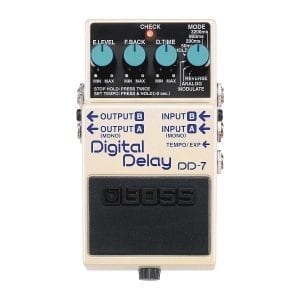 Let’s start with the controls.
Let’s start with the controls.
You’ll have the option of adjusting the level, feedback, and delay time, along with a knob for choosing the mode. The potential delay time is longer than what we found with most pedals, up to 6.4 seconds when you turn it up to max.
But here’s where it gets good:
Boss gives you two modes in this pedal, each of which has its own distinctive tone. The Analog Delay has the warm, classic tone of the old school Boss DM-2 effect, while the Modulation Delay gives you a more modern, chorus-like effect.
There is also a “Hold” mode that lets you store up to 40 seconds of music to use as a loop.
The Boss DD-7 was designed for the gigging musician from top to bottom. The sound quality of the effect is one result of this, but it’s also designed to integrate easily into a professional set-up.
There’s a jack for an expression pedal or footswitch, if you want to control the effects hands-free, and the stereo input and output give you more sweep, pan, and signal options.
Overall, this is a versatile delay effect for any level of player.
Features:
Choice of stereo or mono input and output
Can link all controls to external footswitch or expression pedal
Well-designed casing is both durable and easy to navigate
Lower frequency response makes it less suitable for synthesizers and other electronic music
If you ask professional studio guitarists to recommend their favorite delay pedal, a good many of them will answer the Eventide TimeFactor without hesitation.
And with good reason.
The features and sound quality are tough to beat, with ten different effects and the option of stereo or dual-mono operation. With all the options on this pedal, the inclusion of a loop effect, as well, is just the icing on the cake.
Now here’s the thing:
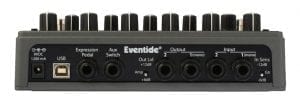 If you’re looking for compact or cheap, you won’t find it here.
If you’re looking for compact or cheap, you won’t find it here.
This is a hefty effect pedal in every sense of the word. Not only does it include multiple modes of both loop and delay effects, it also has ten knobs, three footswitches, and an option for adding an external footswitch for additional controls. Once you have your settings dialed in, you can save them easily into one of the 100 preset slots.
Every detail on this pedal is designed for professional musicians.
One handy feature you won’t find on many pedals is the inclusion of both guitar- and line-level inputs and outputs. It also has tap tempo and MIDI clock syncing—two of the features that make it just as appealing in the studio as it is on stage.
Are you ready for the truth?
It’s not an exaggeration to say the TimeFactor is the last delay pedal you’ll ever need.
Not only is the casing die-cast and built to last, but the software comes with endless free upgrades so it will never become obsolete.
If you’re looking for a simple effect, this is probably more pedal than you want. For the professional who’s looking for the ultimate in delay technology, though, the TimeFactor will give it to you for a lifetime.
Features:
Very durable cast metal casing
Extensive controls allow you to produce any style of delay or loop effect
Inputs and outputs for both guitar and line level
Studio-ready sound with a true analog signal bypass
Large footprint
Most expensive pedal on the list
Analog delay pedals are often more expensive than their digital equivalents. If you want that distinctive analog delay sound, though, there’s just no alternative.
No doubt about it…
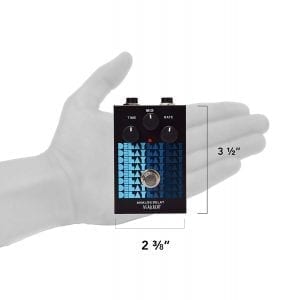 The Delay Lay Lay by Deadbeat Sound is one of the most affordable ways to add an analog delay sound to your arsenal.
The Delay Lay Lay by Deadbeat Sound is one of the most affordable ways to add an analog delay sound to your arsenal.
Unlike other options on the list, the Delay Lay Lay doesn’t boast a plethora of modes and styles.
The effect can be best described as a tape delay, giving your lines a lush echo. You can adjust the length of the delay between 140 and 360ms. The controls are smooth and sensitive and let you make some very minor adjustments.
Since it can go into infinite repeats, you can drive it to the over-saturation point that lets you build up a powerful feedback loop.
When it comes to the versatility of the Delay Lay Lay, that’s a bit of a tricky question. It only offers one effect, but that effect is done exceptionally well and you get a lot of control over the intricacies of the delay’s timing and intensity.
The best advice here is to give the pedal a listen and let your ears make the decision.
Features:
Warm analog delay sound
Smooth knobs let you really dial in on your tone
Especially affordable for an analog delay pedal
Casing doesn’t feel quite as sturdy as some of the others on the list
Only offers one effect
TC Electronic designed this pedal from their 2290 Dynamic Digital Delay, taking that advanced effect technology and putting it into a convenient stompbox.
It’s on the larger side (and in the middle of the price range), but if you’re looking for the most innovative option the Nova Delay should definitely be on your short list.
The programmable presets are the main thing people love about this pedal. You’ll get nine different slots for saving your settings.
Switching between them is simple, too.
This is ideal if you want the choice of changing delay styles within a set, saving you a lot of time over manually adjusting each of the dials.
In terms of the settings themselves, there are six delay types and three modulation styles, along with the five basic control knobs, all of which can be used in tandem to create truly unique sounds.
The processor this pedal is based off of is used for studio effects and mixing, and the Nova pedal maintains this quality standard.
This is partially thanks to the true stereo inputs and outputs. The delay will sound full and dynamic as a result, however you have it set. TC Electronics has really thought through every detail of this pedal that will impact your sound.
The spillover feature, for example, gives you a more natural decay when you change from one mode to another, letting you tweak your settings without interrupting your groove. For a pedal that delivers on both sound quality and ease of use, the Nova Delay is an excellent way to go.
Features:
True stereo inputs give more depth to your tone
Dedicated footswitch for activating tap tempo mode
Studio-quality sound ranging from vintage to modern
Large, easy-to-read LCD display can be set to display MS or BPM
Presets may restore to defaults if pedal is out of use for long periods
Can generate some signal noise
Here’s a nifty little option from Donner that scores high marks for value.
It’s one of the top delay pedals you can get at such a great price. The design also makes excellent use of very little space, cramming seven modes of operation into a mini-sized pedal that’ll fit into any setup.
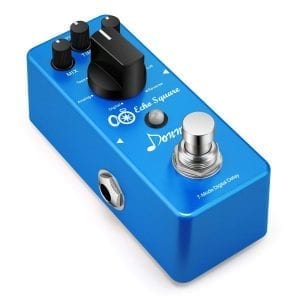 Most pedals in this price range are relatively limited in their sound and setting options, and that’s where the Donner Echo Square really stood out to us.
Most pedals in this price range are relatively limited in their sound and setting options, and that’s where the Donner Echo Square really stood out to us.
Each of the seven delay modes is distinctive, and gives you some less common options, like Mod and Lofi, that are hard to find. Once you’ve picked the mode you want to play it, you can further tweak it using the mix, time, and feedback knobs.
The only disadvantage we found with the controls was that the knobs don’t lock into place, making it a bit more difficult to find your desired settings again if you change them.
There are other small things that you’ll notice you’re missing compared to more expensive delay pedals. The only power option is AC, for example, whereas many larger pedals also give you the option of running on battery.
These small quibbles aside, however, this is a powerful pedal to add to your arsenal—especially considering the price.
Features:
Very affordable
One of the most compact pedals on the list
Unique, full sound on all the modes
Control knobs don’t click into place
No option for battery power
If the main thing you’re after is value, multi-effects pedals are the way to go.
They’ll give you a whole host of different effect sounds in one box—in the case of the Zoom MS-70CDR, 86 effect options for s modest cost.
There’s a definite convenience advantage, too.
How’s that?
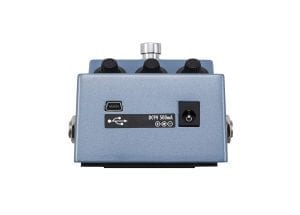 Get the right multi-effects pedal, and it could be the only one you need.
Get the right multi-effects pedal, and it could be the only one you need.
This one even includes emulations of specific pedals, making it really feel like dozens of pedals captured in one casing.
There is a trade-off, of course.
You won’t get as many options for customizing the sound of each individual effect. There’s a basic 3-knob interface (what the knobs do depends on which effect you’re using) but this won’t be enough if you’re a player who likes to really fine-tune their effects.
To our ears, this difference was most obvious when comparing the emulations to the pedals they’re based on. The Zoom MultiStomp sounds similar, but it’s often feels like a flattened version of the original.
Still, a solid multi-effects pedal like this Zoom can be a great thing to have around for those times you want a lot of effect options but don’t have room for a ton of pedals.
They’re a super-smart purchase for a beginner, too, since you’ll be able to play around with a lot of new sounds without investing a ton of money.
Features:
Can use up to 6 effects at once
Delays fade naturally thanks to the Tail function
Also includes common effects like reverb, tremolo, and pitch shifting
Doesn’t offer as much customization for each effect
Doesn’t run especially well on battery power (better to use an adapter)
You might be surprised to see something called the Loop Station on a list about delay pedals, but these two effects are similar in nature and you’ll often see them linked together.
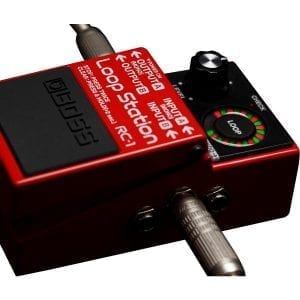 The Boss RC-1 wasn’t our favorite option for delay on the list, but it’s a good one to consider if you like experimenting with long delays and other pedals just aren’t cutting it.
The Boss RC-1 wasn’t our favorite option for delay on the list, but it’s a good one to consider if you like experimenting with long delays and other pedals just aren’t cutting it.
The Boss RC-1 is designed with guitarists and bassists in mind. It has a clean, vibrant interface that’s easy to read at a glance, and you can control all the functions easily using only the built-in pedal.
This intuitive design was probably our favorite thing about the pedal overall—it doesn’t take long to get used to it and it’s very natural once you do.
If you’re looking for a more traditional delay effect…
This might not be the pedal for you.
The long recording memory and simple controls do give it significant versatility, however, and its loop functions are definitely impressive if that’s something you’re interested in, as well.
Features:
Retains recorded material in memory even when powered off
Stereo ins and outs
Easy to use and read
Designed more for looping than delay
Sound is a personal choice and a hard thing to quantify.
When you hear something you like, you know it, and listening to the pedals you’re considering is the only way to discover which ones sound the best to you. Similarly, you’re the only one who knows the scope of your budget.
Want some good news?
You can find great delay pedals that are very affordable, so you don’t have to feel like you’re compromising your sound if you go with a more affordable option.
Beyond sound and price, versatility is the main characteristic that differentiates these delay pedals from each other, in our opinion.
Whether this is something you need to consider depends on how you plan to use it.
Are you going to find one ideal version of the delay effect and keep those settings relatively static once you’ve found them?
Or do you instead prefer to customize your effects to suit the particular style or song that you’re playing?
If it’s the former, you’ll mainly want to focus on finding the pedal that gives you the singular sound you need, but in the latter case you’ll also want to consider how many delay modes the pedal offers, how easy it is to switch between them, and whether it offers the option of saving settings.
Also, keep in mind that you can’t neglect the casing.
The sound is more important, arguably, but you should at least consider the pedal’s size and construction
If you already have a lot of effects pedals in your arsenal, a more compact option could be the way to go. A bigger pedal does give you more space for controls and screens, but you can still find some pretty small options that give you fairly extensive tone-shaping.

The premise behind a delay pedal is simple, but when it comes to execution, things can get pretty complicated.
There’s a wide variety of delay styles even between the pedals on this list. If you’re not completely sure what sound you’re going for, navigating all the options can be a bit overwhelming.
The first decision you need to make when shopping for a delay pedal is whether you want an analog or a digital delay.
The second is what overall delay sound (or array of delay sounds, in the case of many digital pedals) you want to have.
Though control knobs can be used to tweak the tone of any given pedal, this will largely be determined by what delay modes or styles the pedal offers.
The sections below explore both of these questions in more detail to help guide you to the right decision for your tone.
The first decision you have to make is whether you want to get an analog or a digital delay pedal.
One isn’t necessarily better than the other, and both styles have their staunch supporters, but there are significant differences both in the sound and the operation, and when you dig in deep they can get rather technical.
You might find it more helpful to listen to the difference: Digital Pedals vs. Analog Pedals | Guitar Pedals
Analog delay is usually achieved using a bucket brigade delay (BBD) chip that sends the signal through a sequence of capacitors. The more capacitors it travels through, the more the signal breaks up, giving analog delay pedals a distinctive warm sound.
This degradation of the signal does limit the maximum delay time—the signal can only travel so far this way before it breaks up too much to be pleasant.
Digital delay, on the other hand, digitally processes the signal to create the delay. Because it’s achieved using chips instead of capacitors, digital delay offers a lot more control over the effect.
You can choose whether you want it to be warm or bright, and set the length of the delay with a precision you just can’t achieve on an analog pedal.
What it really comes down to is musicality versus flexibility.
Analog delay pedals are more expressive, but on the whole will be more limited both in terms of the length of the delay and how many options you get to tweak it. Digital delay pedals can offer precise customization options, but they can’t quite emulate the depth of an analog effect.
Using a digital effect pedal doesn’t just mean the delay effect will be digital. It will also convert your guitar’s signal from analog to digital when it passes it on to the next stage of the chain.
If you use a solid state amp or other digital pedals, this probably isn’t a deal breaker for you, but it’s still something to keep in mind when you’re deciding where the pedal should go in the signal chain.
You’ll see significant delay pedals—especially digital delay pedals—advertising the number of delay modes the pedal offers. Not every delay style is going to sound the same, but the good news is they’re fairly standardized across brands.
Here’s the deal:
TC Electronic’s tape delay might not sound exactly like Boss’, but they’ll both follow the same basic sound concepts.
If the mode of the delay looks like a model number, that’s likely an emulation rather than a type. In other words, it’s been designed to sound like a specific pedal, most often a vintage analog model that’s difficult to find.
It’s something you’ll only see on digital delay pedals, and it can be an affordable way to get the sound of an iconic pedal without the hefty price tag.
You’ll also often see an “analog” mode on digital pedals. This is a more general emulation of a capacitor-based pedal. If you see a mode that’s just marked “digital delay,” you can usually think of this as the standard or default delay style for the pedal.
Aside from these, there are some broad categories of delay you’re likely to see as you’re perusing effect pedals. This list certainly isn’t comprehensive, and some brands come up with their own names for these mode styles, but the list below covers the most common styles.
Modulation Delay
 Also called “Modulated”, or even just “Mod” delay, this is an effect based on the same basic ideas as a chorus or flanger. Since the delay time is variable, though, it gives the player a bit more control over the length of the effect than your typical chorus pedal.
Also called “Modulated”, or even just “Mod” delay, this is an effect based on the same basic ideas as a chorus or flanger. Since the delay time is variable, though, it gives the player a bit more control over the length of the effect than your typical chorus pedal.
It’s a more subtle form the delay, for sure, but it adds a bit of extra movement to your tone that gives it a more organic character. If you already have a chorus pedal that you love, you may find a Mod delay to be a bit redundant, but it’s a popular option across genres to add a touch of chorus that doesn’t sound artificial or cheesy.
Tape Delay
This is an effect emulating a style of delay employed in pedals in the ‘50s and ‘60s. These pedals used an analog tape system to achieve the delay, and were some of the first pedals to use tube circuitry in the preamp, which both gave them extra warmth and made them a bit noisier.
They also tended to be the most organic-sounding delays, especially in the early decades of delay pedals. They were known for producing extra effects on the sound, too, often called either “wow” or “flutter.”
These are subtle effects that sound similar to a phrasing or flanging effect.
Reverse Delay
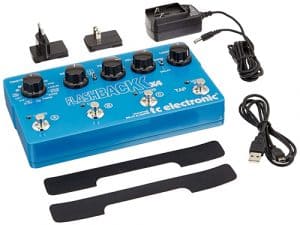 You may also see this called “Reverse Regeneration” or “Backwards delay,” and it’s basically what you’d think from reading the name: an effect in which the delay to your tone sounds like a recording played backwards, behind your standard tone.
You may also see this called “Reverse Regeneration” or “Backwards delay,” and it’s basically what you’d think from reading the name: an effect in which the delay to your tone sounds like a recording played backwards, behind your standard tone.
It was said to have been invented by Jimmy Page all the way back in the late ‘60s. Despite its long history, though, this is a more specialized effect that doesn’t get used as widely as other delay variants.
It’s most often heard in modern pop and rock styles, including hardstyle, EDM, and shoegaze.
Ping Pong Delay
This is another one whose name is descriptive. A Ping Pong delay is typically a stereo delay pedal effect in which the delay signal is bounced back and forth between the left and right channels.
You may also see Ping Pong delays that are bounced from one mono channel to another during play, especially in pedals lacking stereo channels. The key is the delay always happens on the edges of the sound rather than in the center of the field.
This is one way to add more three-dimensionality to your tone. It also tends to use a drier delay than other modes, which is good if you prefer a less saturated effect sound.
Slap Delay
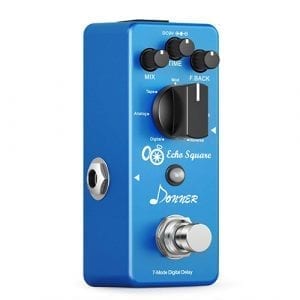 Also called “Slapback delay,” this usually refers to a single echo effect that lasts between 60-180ms.
Also called “Slapback delay,” this usually refers to a single echo effect that lasts between 60-180ms.
More than an audible delay on your tone, it gives the notes a thicker, wetter sound. This isn’t always restricted to use with guitars, either.
More than other delay styles, slap delay is popular with sound engineers for vocal lines, and was famously used by Elvis Presley on recordings. The slap delay is typified by a short delay time and a tight mix with the dry signal. Slap delays also tend to be louder than other delay styles, and have a far more pronounced presence in your overall tone.
They’re most popular for drums in rockabilly and other ‘50s-era styles.
Lofi Delay
 In most digital effect modes, the delay sounds identical each time it repeats. With a Lofi Delay, the signal degrades with each repetition, similar to an analog delay effect.
In most digital effect modes, the delay sounds identical each time it repeats. With a Lofi Delay, the signal degrades with each repetition, similar to an analog delay effect.
The difference is that Lofi Delay uses a digital signal degradation. “Lofi” is actually short for “low fidelity,” and knowing that might help to make things a little clearer.
It’s basically an emulation of the effect of lower-quality audio equipment on a tone, but in a controlled fashion, and is a popular way to add a vintage color to your tone.

Even after you’ve purchased your delay pedal, your decision making isn’t quite over. There’s still the question of how you’re going to connect your various pieces of gear together for the best sound.
For the most part, this will be a matter of personal preference, putting your effects pedals in the right order in the chain to give you the exact sound you’re looking for.
In some situations, though, you may also need to consider the relative power handling and impedance of each piece of gear to prevent potential damage and use all of your gear to its full potential.
Before we get into the details of where to position different items within the signal chain, it’s important to understand a bit about watts, ohms, and what they mean for your signal and your sound.
The impedance of a piece of gear is a measure of the amount of resistance the electrical signal will encounter when it enters the device.
With amps and speakers, it’s important for the impedances to match. With pedals, the impedances don’t need to match, but you do need to pay attention to which side of the connection is higher.
Visualize this:
Think of water flowing through a pipe.
If the pipe is a consistent diameter the entire way, the water pressure will remain constant. If the diameter changes, though, so will the pressure, going down if the pipe gets larger and up if it gets smaller. If the pipe gets too small, the water pressure could get so intense the pipe bursts.
This isn’t a perfect analogy, but it’s the same basic concept as a signal traveling through gear with different impedances.
Your pedals, amps, and speakers have two impedance ratings: one for the input and one for the output.

A good rule of thumb for pedals is that as long as the output impedance is lower than the input impedance, everything will work fine
This rule of thumb applies both to chaining pedals together and to connecting them to your amp. There are other subtleties to how impedance affects guitar tone, but as long as you follow that rule above, you won’t have any problems.
This is most important for the pedal that you’re connecting to the amp.
Guitar pedals don’t generate enough power to cause a blowout. If the relative impedance is off between pedals, you won’t damage your equipment—it just won’t sound as good.
What’s the bottom line?
The impedance of an effects pedal doesn’t impact whether or not you’ll be able to use it, just where you need to put it in relation to your other gear.
Because of that, it’s not likely to play a big factor in your purchasing decision unless it’s important to you to buy a delay pedal to go before or after a specific effect. If that’s the case, it’s a good idea to check and make sure the pedal will work where you want it in the signal chain before you buy to avoid a frustrating discovery later.
Now, onto the fun part.
Technical concerns aside, how you order your effect pedals can be a fun way to play with your sound.
You might be surprised by how much of a difference it can make to swap the order of the pedals in your signal path. While there aren’t any hard and fast rules, there are some general guidelines that most people follow when they’re setting up their pedal rack.
If you’re just getting started working with multiple effects, this can be a good order to follow for your initial set-up.
The typical approach is to order the effects the way they would be applied if they were occurring naturally.
This would mean pedals that add noise or produce sound (compressors, wah pedals, distortion, etc) should go at the start of the chain.
Following this would be signal modifying effects, like volume or chorus pedals. Finally, you’d add effects that mimic the space or atmosphere. This is where a delay pedal fits in, as well as effects like reverb or echo.
Guess what?
This doesn’t mean you have to put your delay pedal at the very end of the signal chain.
Most people do put them in the back half of their signal chain, but delay pedals are one of the more versatile effects when it comes to placement. You can make a really cool effect by putting a volume pedal directly after the delay pedal, for example.
There’s a great video from Howcast that shows you how to do it and what it sounds like here.
There are other reasons why the typical pedal board is set up the way it is. The most important one is probably to keep the noise level low. Signal noise is a potential concern once you start stacking multiple pedals together on your board.
If you are finding some unwanted noise in your sound, shifting the order of the pedals is one way to alleviate it.
If you’re trying to emulate a specific player’s sound, putting your effects in the same order is key to getting itIf not, though, you should feel free to experiment.If you’re curious what your delay pedal would sound like first in the signal chain, give it a shot and see what you think. As we pointed out above, you can’t do any harm; if you don’t like it, you can move it right back.
 Adding a delay pedal to your guitar setup can greatly expand the sonic potential of your instrument. The key is to find the one that best complements the other equipment that you use. Listening to the pedals in action with the video links above can give you a basic idea of a pedal’s overall sound.
Adding a delay pedal to your guitar setup can greatly expand the sonic potential of your instrument. The key is to find the one that best complements the other equipment that you use. Listening to the pedals in action with the video links above can give you a basic idea of a pedal’s overall sound.
But remember…
Unless you’re using the exact same gear as the person recording the video, it’s going to react a little differently with what you’ve got going on in your rig.
Of course, there’s no one right answer when it comes to picking a delay pedal.
They’re one of those effects that pretty much every guitarist needs to have, and there’s plenty of contention about exactly what makes one pedal better than another.
But if you want our opinion, the two picks below are great options:
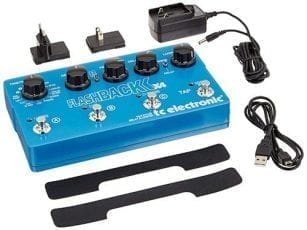
Don’t want to sacrifice sound or spend a lot of cash? Find the perfect balance with the best delay pedal reviews.
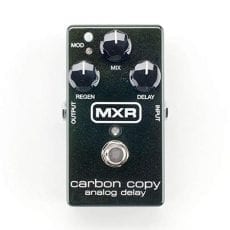
Don’t want to sacrifice sound or spend a lot of cash? Find the perfect balance with the best delay pedal reviews.
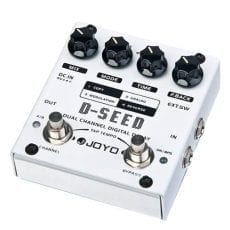
Don’t want to sacrifice sound or spend a lot of cash? Find the perfect balance with the best delay pedal reviews.
The only thing you’ll absolutely need are cables to connect the pedals to your other equipment. Effects pedals use a standard input/output size of ¼” plugs, so you can use the same cables for all of your pedals. If you don’t have any yet, getting a multi-pack of 6” cables can save you the hassle and cost of buying each individually.
The only other thing you’ll need to buy for most pedals is a way to power it—either spare 9V batteries or a PSA adapter. Many pedals will offer you both options. Battery power is a convenient option to have, but you should be prepared to change the batteries frequently; most delay pedals will only give you 4-6 hours of playing life from a fresh battery. An AC power source isn’t just more economical, either. Some pedals won’t perform at maximum power on batteries, making an outlet the best way to get a good sound.
Most effects pedals you buy are aimed at guitarists, and the delay pedals on this list are no exception. That doesn’t mean they’re necessarily limited to use with guitars, though. Any instrument that you’re playing through an amp using a pickup can send its signal to an effect pedal.
As far as how delay pedals specifically work with other instruments, on the whole all of these pedals will work just as well with electric basses. You can also pair many of them very effectively with electric keyboard instruments, including synthesizers. As a rule of thumb, digital effect pedals work better with synthesizers than analog ones. The Zoom Multistomp is an especially popular choice for electronic keyboardists.
If a pedal says it uses a true bypass, this means your guitar’s signal is not affected by the pedal at all when you’re not using the effect. If a pedal doesn’t have a true bypass, there may be some slight buffering of the signal even if the pedal isn’t in use, so long as it’s plugged in as part of your effects chain.
The degree to which the signal is affected will be different depending on the pedal. In some cases, it will be so subtle that you’ll hardly be able to notice it. Some people even like the little bit of compression that you get from a pedal without a true bypass. If you want to maintain absolute signal integrity, however, you should look for a pedal with this feature, especially since the delay effect is likely to be one you won’t use the entire time you’re playing.
